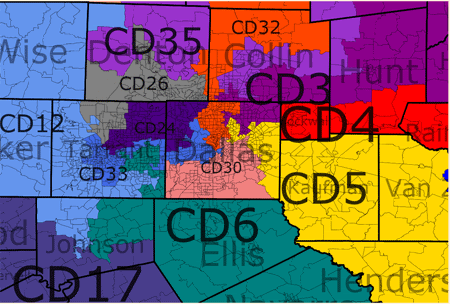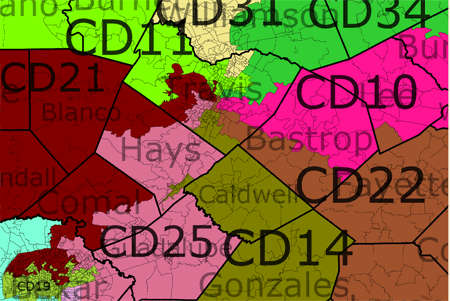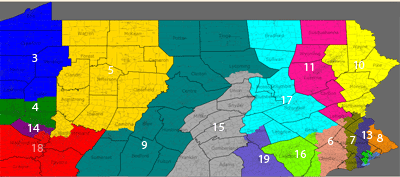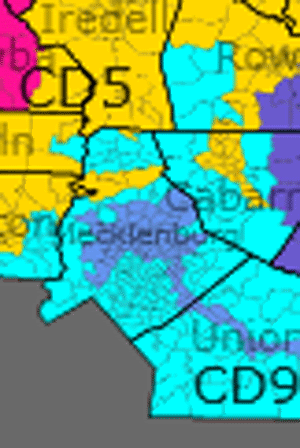Redistricting Texas was a bit of a chore. To do this with an eye to how the GOP legislature might do so requires balancing a number of considerations. These are at loggerheads with each other to some degree:
(1) A desire to protect new GOP incumbents Farenthold and Canseco;
(2) A desire to shore up increasingly vulnerable GOP incumbents in TX-10, TX-24 and TX-32
(3) Compliance with the VRA.
First, a primer on the VRA. It does not require that a state with a 38 percent population have 38 percent of its districts be Hispanic opportunity districts. It doesn’t necessarily require any.
Instead, it requires only that distinct populations be given a reasonably compact district if it is possible to draw one. This is a problem in Texas, where the Hispanic population is fairly subsumed within the anglo and African American populations. West Texas has a fairly large Hispanic vote, but it is impossible to create anything approaching a minority majority district there — in fact, almost all of these districts have at least a 15% Hispanic population, but they can’t be used to draw a compact district. In the 2006 Texas redistricting litigation, the district court found that Texas could support only 6 Hispanic opportunity districts (although I counted 7). I don’t think it has increased all that much recently.
There’s a second complication in Texas, which is that there’s a difference between the population and the voting population. Both undocumented and documented workers count for census purposes, even though neither can vote. In Texas this creates a substantial discrepancy between the numbers shown by census voting-age population (VAP), and the Citizen Voting Age Population (CVAP). Throw in lower turnout among hispanics in general, and it gets very difficult to draw VRA districts.
The basic theory behind the map, therefore, is as follows. Keep all the present Hispanic opportunity districts as close to the current lines as possible. Anything that’s around 60 percent Hispanic should be an Hispanic opportunity district (the district Court in 2006 seemed to accept that TX-25 would be an Hispanic opportunity district with 55% Hispanic population; it was struck down because it was not sufficiently compact to count as a VRA district). If you can keep the white vote below 30% or so, that can change, although an African American population that starts to approach the Hispanic population can overwhelm it in a Dem primary.
I created something looking like an Hispanic opportunity district in the DFW area. To illustrate just how difficult this is, you’ll note that this and the 30th are now awfully close to electing an Anglo Democrat, and these lines are pretty convoluted. It may well be that the VRA doesn’t require any additional minority-majority districts in Texas, although drawing close to one in DFW is a good idea for shoring up GOP incumbents.
A few other notes. I didn’t know exactly where Blake Farenthold lived, so I drew his new district to where Farenthold Consulting was located. The baconmander of Dallas county is avoidable with precise locations for the incumbents; because I didn’t want to draw two Congressmen together, I kept the Dallas portions of their old districts more-or-less intact.
The centerpiece of the map is the 8-way split of Austin. I don’t know where Lloyd Doggett lives and I don’t think it matters; he runs in a 58 percent McCain district no matter what.
I have to say, given what I did, I was pleasantly surprised that the districts look as regular as they do. It might actually look better than the current map . . .
Without further adieu…

(1, Gohmert) 31% Obama/68% McCain, 70W/17B/11H (old 31O/69M, 68W/18B/13H) — Gohmert’s district goes further South now, but retains the Tyler base. Without the Dallas Baconmander, it could be made more compact.

(2, Poe) 40Obama/60McCain, 61W/13B/22H (old 40O/60M, 57/21/18) — This district grew 14 percent and has to shrink — it is now contained almost entirely within Harris County. A leg goes down to Galveston and Texas City to take Democratic votes from the 14th to offset the votes that district gains in Austin (cue ominous foreshadowing music).

(3, Johnson) 40Obama/59McCain, 65W/11B/16H (old 42O/57M, 56/10/21) — This baconmander would be avoidable if I knew where Johnson resided (even better if he retired . . .). For now, it takes in its old portion of Dallas, and then extends out to rural North Texas. It is made slighly more Republican.
(4, Hall) 30O/70M, 75W/16B/7H (old 30/69, 75/10/11) — Because of the situation with the Third district, this has to be pretty grotesque. This one is also much easier if Hall retires, or with his precise location (as that would allow using some of Rockwall to shore up the third without putting it out in N Texas, which in turn would allow the 4th to keep its old shape.
(5, Hensarling) 39O/61M, 69W/13B/14H (old 36/63, 65/13/19) — Hensarling’s district doesn’t change all that much, though due to population growth it loses some heavily Republican rural portions. Still, he should have a nice home for the rest of the decade.
(6, Barton) 37O/63M, 68W/12B/15H (old 40O/60M, 58/15/21) — Normally I wouldn’t have shored up a district, but Barton is a bit, um, controversial, so I thought he would want to know that his district would be safe through 2020.
(7, Culberson) 40O/59M, 62W/6B/24H (old 41O/58M, 59/8/23) — This district retains much of its old territory. I made it a touch more Republican. I figured if Culberson got 56% of the vote while being outspent 2-1 in 2008, he was going to be pretty safe. My first time through I had this at 61 percent, but then my computer crashed before I wrote it up. So this could be improved.
(8, Brady) 31O/68M, 74W/6B/14H (old 26O/72M, 77/9/12) — This district is now entirely within Harris and Montgomery Counties, which should make Brady happy. It’s a bit more Democratic, but I don’t think he’ll notice.
(9, Green) 74O/26M, 19W/34B/34H (old 77/23, 14/36/40) — Al Green’s district expands to pick up some more African American voters, and sheds some white voters to the 7th. Not much change here.

(10, McCaul) 40O/59M, 62W/12B/21H (old 44/55, 59/10/25) — McCaul is one who could use some help — although in a terrible Republican year he beat back a stiff challenge handily. His district gets some more Houston suburban lovin’, which ratchets it up a few notches.
(11, Conaway) 41O/59M, 64W/6B/26H (old 77M/24O, 61/4/33) — This district retains its Midland base, but picks up a chunk of Austin to become quite a bit more Dem. Still — and this is important to remember for the rest of the map — 59%McCain is still roughly R+13, which should be enough to win throughout the decade.
(12, Granger) 35O/64M, 79W/4B/11H (old 36/63, 63/6/27) — Not a lot of changes here; drops some of its minority population to create the new 33rd.
(13, Thornberry) 23O/76M, 69W/6B/23H (old 23/76, 70/6/21). Not much you can do here — the district is Amarillo, and there isn’t another Democratic hub within 500 miles of the place. Note, however, that the district is a quarter Hispanic. This is what I’m talking about re the problems of creating Hispanic majority districts here.
(14, Paul) 41O/58M, 57W/8B/32H (old 33O/66M, 59/9/27) Paul gets a chunk of Austin as well. It is a more Democratic district, but he should still be able to win pretty handily.

(15, Hinojosa) 66O/33M, 13W/0B/85H (old 60/40, 17/2/80) — This district has grown a lot, and so it shed some of the anglo counties to the north. Hinojosa actually had a bit of a close call in ’10, but that won’t happen again in this district.
(16, Reyes) 68O/31M, 15W/3B/81H (old 66O/33M, 14/3/81) — No big changes here.
(17, Flores) 35O/64M, 67W/15B/15H (old 32O, 67M, 69/10/18) — This district is a bit more Democratic, but its a ton of new territory, which should prevent a Chet Edwards comeback.
(18, Jackson Lee) 83O/16M, 19W/51B/26H, (old, 77O/22M, 16/38/42) — The original Texas minority-majority district, it sees its African American percentage increased substantially, as it shed white voters to the 7th and Hispanics to the 29th.
(19, Gonzales) 66O/33M, 22W/9B/66H (old 63/36, 21/6/70) — I switched the 19th and 20th, because I’m colorblind and was having troubles with the 19th and 23rd. This gives up some population to the 28th, which allowed me to do an ugly gerrymander that shored up the 21st to compensate for getting parts of Austin.
(20, Neugebauer) 27O/72M, 67W/6B/24H (old 27O, 72M, 61/5/32) — Again, not much you can do with these voters. In theory you could put this one into Travis County as well, but that would be greedy. Also, note the 32 percent Hispanic population.
I really should have broken this into two pieces.
(21, Smith) 40O/58M, 70W/3B/23H (old district 40O/59M, 63W/7B/26H) — Smith never had any troubles in his old district, so the addition of the Austin territory shouldn’t hurt him. It’s not downtown Austin, so we’re not talking heavily Dem stuff.
(22, Olson) 41O/58M, 60W/9B/22H (old district 41O/58M, 51W/13B/24H) — this gets some of Austin as well. But unless Olson gets himself indicted for money laundering and the GOP runs a write-in candidate with a hyphenated last name, he should be ok.
(23, Canseco) 47O/52M, 36W/2B/60H (old district 51O/48M, 29W/3B/66H) — I think this is testing the outer limits of what you can do and still comply with the VRA here. It should still be considered an Hispanic opportunity district though, although one that leans more to the right. In a bad GOP year, it will probably elect a Democrat.
(24, Marchant) 38O/61M, 68W/6B/18H (old district 44/55, 53/12/25) — Marchant is another big winner from the creation of the 33rd. A substantial increase in Republican performance here.
(25, Ducky) 43O/56M, 61W/5B/31H (old district 59O/39M, 51W/9B/37H) — A small sliver into Corpus connects Farenthold to what is essentially a new South-Central Texas district. I would have liked to have gotten the GOP percentage up a few more notches, since he is so weak, but it just isn’t feasible. This doesn’t go much into downtown, so I don’t think I picked up Dogget’s residence.
(26, Burgess) 37O/62M, 77W/6B/11H (old district 41O/58M, 62/13/19) — Burgess is another Dallas winner. his district has seen massive growth, so this is quite a bit more compact. He loses quite a bit of minority population to the 33rd.
(27, open) 53O/46M, 27W/2B/69H (old district 53O/46M, 25W/2B/71H) — Since the old district elected a very weak Republican once, I figured that I should keep it more-or-less intact if possible, on the off chance that it might do so again. The only real change is that a few rural precincts are added, and three Corpus precincts are put into the 25th.
(28, Cuellar) 70O/30M, 11W/3B/85H (old district 56O/44M, 19W/1B/79H) — This district gets a bigger chunk of Hispanic voters in San Antonio who are apparently MUCH more reliable Democratic votes than those on the border. Cuellar may actually not be able to survive here.
(29, Green) 63O/36M, 20W/10B/67H (old district 62O/38M, 16/10/72) — This remains an Hispanic opportunity district, which would probably still elect an Anglo Democrat. Again, this illustrates just how tough it is to really create a Hispanic opportunity district here.
(30, Johnson) 79O/21M, 26W/44B/27H (old district 82/18, 17/39/41) — This district has to become quite a bit whiter in order to help make the 33rd. Still, Johnson should win the primary and the general.
(31, Carter) 40O/58M, 71W/7B/18H (old district 41/57, 63/12/19) — Carter gets a little boost in Republican performance, but he was never really in any jeopardy in the first place.
(32, Sessions) 40O/59M, 69W/6B/19H (old district 46/53, 44/8/42) — After a relatively close shave against a weak opponent in 2008, Sessions gets a big boost from creating the 33rd. It is a bit ugly; in reality if I knew where Johnson and Hall lived, I’d probably push it more into the 3rd, push the 3rd more into the 4th, and have the 4th get a lot of this northern Collin County territory. But I might inadvertantly put those guys in the same district, so you get what you get.
(33, new) 71O/29M, 25W/21B/50H Minority-majority district. Its ugly, and it still might elect a white Democrat. But its the best you can do and even if the GOP doesn’t HAVE to draw it, it will probably still try to do so to shore up the other Reps.
(34, new) 39O/60M, 67W/11B/18H
(35, new) 35O/63M, 78W/5B/11H
(36,new) 37O/62M, 66W/17B/13H








